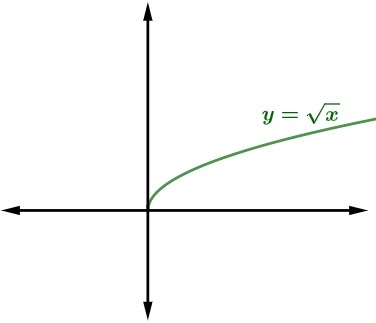A flag of Portugal It is one of the country's national symbols. The current version of the pavilion was developed in the year 1910 and officially adopted from 1911 through a government decree.
It is composed of a green and red rectangle (with the green portion positioned on the left) that symbolizes the hope and blood of those who fought for Portugal. These colors were also used in the revolution that culminated in the establishment of the republican regime in the country. On the line that divides the colors is the armillary sphere, symbol of the grwalk Atvegations, and the Portuguese National Shield, which recounts important moments in the history of Portugal.
Read too: Flag of Germany — a flag representing the country's unity, freedom, and democracy
Topics of this article
- 1 - Summary about the flag of Portugal
-
2 - Meaning of the flag of Portugal
- → Meaning of the colors of the flag of Portugal
- → Meaning of the armillary sphere of the flag of Portugal
- → Meaning of the castles on the flag of Portugal
- → Meaning of the shield of the flag of Portugal
- → Meaning of the bezants on the flag of Portugal
- 3 - Rules on the use of the flag of Portugal
- 4 - History of the flag of Portugal
- 5 - Main characteristics of Portugal
-
6 - Other flags of Portugal
- → Flag of the President of the Republic
- → Flag of the Parliament of Portugal or Assembly of the Republic
- → Flag of the Prime Minister of Portugal
- 7 - Curiosities about the flag of Portugal
Portugal flag abstract
The current flag of Portugal was officially adopted in 1911 and represents the transition from monarchy to republic.
The colors dark green and red are predominant in the Portuguese flag. They replaced the dominance of blue, the color of the old monarchical regime.
Green represents hope and also the revolution that led to the establishment of the republican regime in the country. Red represents the blood of those who gave their lives in defense of Portugal at different times in national history.
The armillary sphere is an astronomical observation and orientation instrument that appears on the Portuguese flag over the dividing line between the green and red parts. It represents the period of the Great Navigations, of great importance in the history of Portugal.
The golden castles on the flag of Portugal represent seven existing castles and fortresses in the Algarve region, in the south of the country. It was in this region that the areas occupied by the Moors were retaken.
Inside the shield, seven corners are represented, which resemble small shields, in blue. They symbolize the five Moorish kings defeated by Dom Afonso Henriques, king of Portugal at the time. Inside the corners, there are bezants, which represent the wounds of Christ.
The rules for the use of the Portuguese national flag were established through Decree-Law nº 150/87, of March 30, 1987.
Do not stop now... There's more after the publicity ;)
Portuguese flag meaning
The flag of the Portuguese Republic, or Portugal, is one of the national symbols of the country. It is formed by a rectangle divided into two parts, each with a different color: the smaller part is dark green, and is always positioned on the left, close to the mast. The larger division is bright red in color. On the line that marks the division of colors, the armillary sphere is positioned and, over it, the Portuguese coat of arms.
According to Portuguese law, the meaning of the flag of Portugal is national sovereignty and the independence, unity and integrity of Portugal.|1|
The current version of the flag of Portugal symbolizes the republic, Form of government adopted by the country at the beginning of the 20th century, more precisely in 1910, officially marking the end of monarchy.
With the change in regime, there was a resignification of the nation's symbols, especially the national colors and the way they are arranged on the flag. Each of the symbols and colors present in the pavilion has a particular meaning that portrays the history and politics of Portugal.

→ Meaning of the colors of the flag of Portugal
The colors green and red are predominant in the current flag of Portugal and were chosen to represent the new form of government to the detriment of blue, the color previously used by the monarchy. The meaning of these colors, in addition to the regime change, is based on different interpretations, which we present below.
Green: was introduced in the flag of Portugal from 1910. Before that, the color had not been used in the Portuguese flag without association to a specific symbol, such as the coat of arms, unlike red. One of the main meanings of green is the feeling of hope. The color was also present, along with red, in the republican revolution, which led to the implementation of the new regime, this being another possible symbology.
Red: is a color historically used in the flag of Portugal. It represents the blood of those who fought to defend the country at different times in its history. Red is also associated with combativeness and victories.
Important: White, gold and blue also make up the flag of Portugal, but to a lesser extent than green and red. They are present on the armillary sphere and on the Portuguese shield.
→ Meaning of the armillary sphere of the flag of Portugal
The armillary sphere was an instrument that indicated the position of the stars in the sky, of great importance for astronomical studies and for orientation in space, especially for navigation.
Let us remember that Portugal he was considered a pioneer country in long-distance maritime exploration, having crossed the Oatlantic ocean and arrived on the American continent at the end of the 15th century. This period became known as the Great Navigations.
Therefore, The armillary sphere is a symbol of this feat, and a representation of this instrument appears on the Portuguese flag in gold and positioned on the dividing line between the colors green and red.
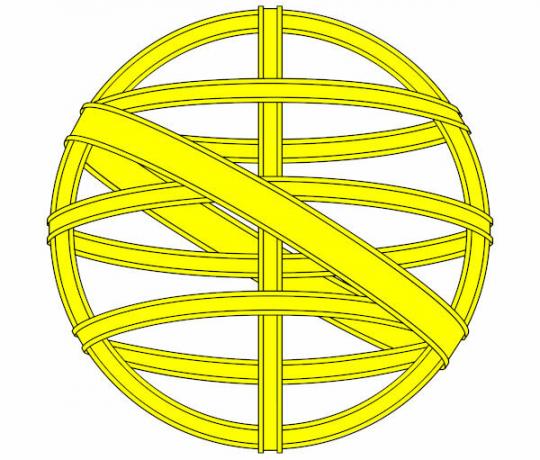
→ Meaning of Portugal flag castles
Seven castles are stamped on the flag of Portugal in gold, around the bezants (corners), thus forming the Portuguese coat of arms. Each one of them represents a castle (or fort) that actually exists and is located in the Algarve region, in the south of Portuguese territory and with access to the Atlantic Ocean:
Cacela Velha;
Albufeira Castle;
Aljezur Castle;
Castro Marim Castle;
Estombar Castle;
Paderne Castle;
Fortress of Sagres.
→ Meaning of the shield of the flag of Portugal
The coat of arms of the Portuguese flag is formed by the seven castles that we have just seen and by five corners in blue on a white background. all your composition refers to the victory of the Portuguese over the Moors, who occupied the Iberian Peninsula from the 8th century onwards.
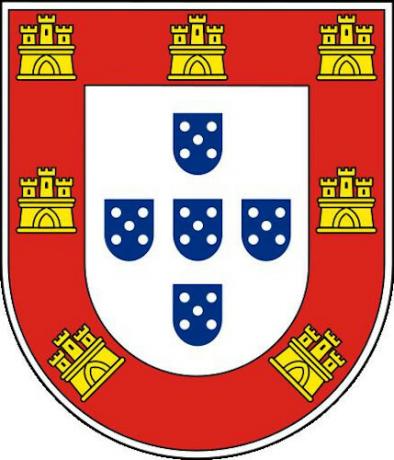
The castles on the red background represent the fortifications of the areas retaken by Portugal, during the reign of Dom Afonso Henriques, which were under the dominion of the Moors. The disputes took place in the southern region, now known as the Algarve. The corners in blue, which resemble shields, represent the five Moorish kings defeated by the Portuguese. Inside each of these shields are the bezants.
→ Meaning of the bezants on the flag of Portugal
The bezants are the white dots represented inside the blue corners of the coat of arms of the Portuguese flag. The most accepted interpretation of this symbol is that it represents the wounds of Jesus Christ, seen by King Dom Afonso Henriques before the start of the battle against the Moors.
Rules on the use of the flag of Portugal
The rules for the use of the flag of Portugal were established through Decree-Law No. 150/87, of March 30, 1987. The decree is composed of 10 articles and their respective paragraphs, and was signed by the president of the republic and acting prime minister at the time. See some of the rules for the use of the Portuguese national flag:
The flag to be used must comply with the official standard and be in good condition, preserving its dignity, according to the legal text.
Sundays, holidays, official ceremonies or solemn public acts and sessions are dates and occasions on which the flag must be hoisted.
When on other days, hoisting must be justified by the government of Portugal or by regional and local authorities.
The flag can be hoisted daily in the buildings of national sovereignty.
Other buildings, such as military and civilian bodies, institutes and public companies, can fly the national flag. When outside the headquarters, the established rules must be adhered to.
The flag must remain hoisted between 9 am and sunset. If it stays at night, it should be illuminated by spotlights.
In case of national mourning, the flag must be flown at half mast during the officially determined period.
History of the flag of Portugal
The current flag of Portugal was adopted in the year 1911, almost 800 years after the appearance of the first official flag of the country, which dates from 1143.
It was in that year that Portugal became a sovereign and independent nation., becoming governed by King Dom Afonso Henriques. The pavilion was then composed predominantly of white and blue, and around 1183 the addition of bezants was made.
In the 13th century, the castles on the red stripe became part of the Portuguese flag, although in a different number and arrangement than those we have today. Several alterations have been made to the standard in the intervening centuries., especially in moments of alternation of power, with the change of the monarch who occupied the throne of Portugal.
In the 15th century, for example, the shield was incorporated into the flag along with a royal crown. During the reign of Dom Manuel, the armillary sphere composed his personal banner, made in gold on a red and white background. This symbol, however, was not yet part of the national flag.
Portugal assumed a new flag during the Iberian Union, a political period marked by the unification of the Spanish and Portuguese Crowns, between 1580 and 1640. Another moment in which there was a significant change in the national standard was at the beginning of the 19th century, with a decree of Dom João that raised Brazil to the status of a kingdom, thus creating the United Kingdom of Portugal, Brazil and Algarves. The flag was composed of the Portuguese coat of arms, the armillary sphere and a crown.
The last flag of the Portuguese monarchy had a blue and white background, colors that represented, in the country, that regime of government, in addition to bearing the shield and the royal crown. Green and red were instituted as the national colors as soon as the new regime, the republican one, was implemented in Portugal, on October 5, 1910.
That same year, a commission was set up to design a new flag for the country, approved on November 29. Its official adoption, through government sanction, took place on June 19, 1911.
See too: Flag of Brazil — another flag adopted after the end of a monarchy
Main characteristics of Portugal
Portugal is a European country located on the Iberian Peninsula, bathed by the Atlantic Ocean and bordering only one other country, the Spain. The Portuguese capital is the city of Lisbon.
With an extensive coastline of almost 1800 km, the Portuguese territory presentsclimates that vary from Mediterranean to the tempered continental, with mild annual temperatures and average rainfall between 1000 mm and 2000 mm.
the features of relief in Portugal are quite heterogeneous, presenting mountainous areas It is small hills and plains. The same happens with the vegetation, which is divided into temperate forests and Mediterranean vegetation.
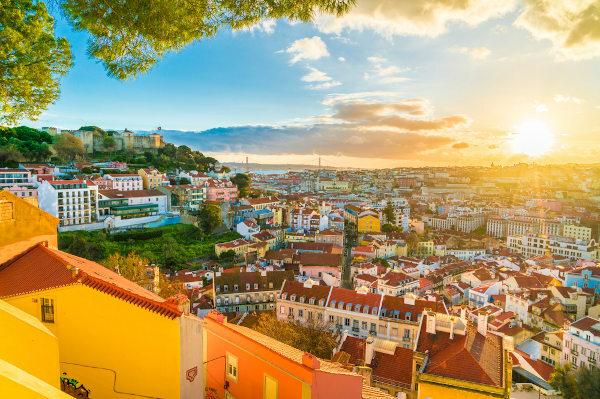
Portugal occupies the 14th position in the list of the most populous countries in Europe, with more than 10.1 million inhabitants. Most Portuguese live in cities and areas closer to the coast. There is also an important demographic trend underway in Portugal, which is the aging populational. This trend can be seen in other European countries.
Part of European Union, the Portuguese economy is based on the trade and services sector, in which tourist activities and finance stand out.
Other flags of Portugal
Other flags are used in Portugal in addition to the national flag, representing government authorities, republican bodies and the military. See below some examples of Portuguese institutional flags.
→ Flag of the President of the Republic
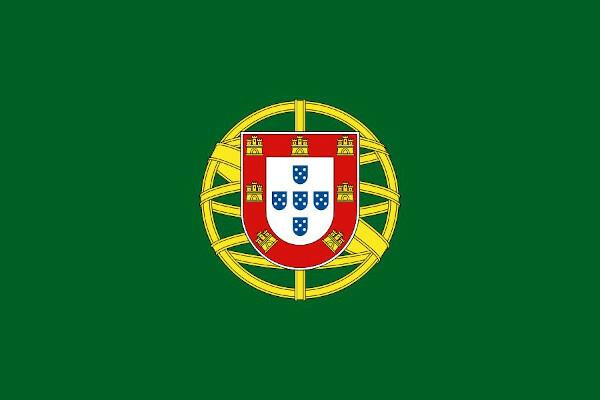
→ Flag of the Parliament of Portugal or Assembly of the Republic
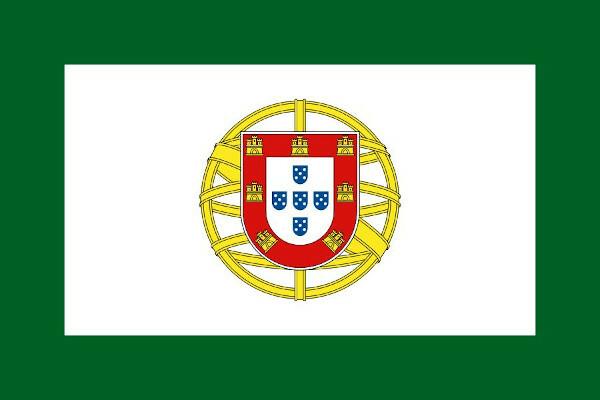
→ Flag of the Prime Minister of Portugal
![Flag of the Prime Minister of Portugal. [1]](/f/df2d4663d5602daa8a4c62fa877a37b3.jpg)
Curiosities about the flag of Portugal
The flag of Portugal is also called the Verde-Rubra Flag and the Quinas Flag.
Portugal met its new official flag on December 1, 1910.
The composition of the current flag of Portugal was conceived by a commission composed of the following people: Columbano Bordalo Pinheiro (painter), Abel Botelho (writer), Antonio Ladislau Parreira (army officer) and João Chagas (journalist).
Note
|1| PRESIDENCY OF THE COUNCIL OF MINISTERS. Decree-Law No. 150/87, of March 30, 1987. Establishes the rules on the use of the national flag. Available here.
image credit
[1] Wikimedia Commons (reproduction)
By Paloma Guitarrara
Geography Teacher
Click here to learn more about the Great Navigations. Find out why Portugal was the pioneer country in this process and what were its accomplishments in it.
The Wars of Reconquest approached the movement of the Crusades, transforming the reconquest of the Iberian Peninsula into a religious war as well.
Did you know that guidance by stars and stars has already been used a lot? Check out!
Discover Portugal, one of the countries of the Iberian Peninsula. Deepen your knowledge of aspects of its history and geography and discover interesting facts about it.

